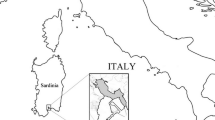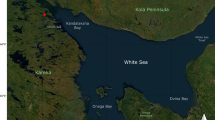Abstract
The anisakid nematode Pseudoterranova decipiens, known as the sealworm or cod worm, can infect the flesh of several fish species. The parasite causes cosmetic problems for the fish industry and can cause abdominal discomfort if consumed by humans. There are only scattered studies on the abundance or distribution of the sealworm in fish and seals in the Baltic Sea. To remedy this situation, the extent of sealworm infection was investigated in cod (Gadus morhua) and shorthorn sculpin (Myoxocephalus scorpius) collected along the Swedish coast. A relative presence of the sealworm was also investigated in samples from grey seal (Halichoerus grypus) stomachs. Up to 100 % of the fish were infected in some of the areas. Sculpin were generally worse infected than cod, both in abundance and prevalence of parasites. General linear models showed a significant correlation between the number of seals in an area and the prevalence of sealworms in cod. There was a sharp decrease of infected fish in areas with salinity lower than 7 ‰. Even though the northern Baltic proper and the southern Bothnian Sea have a high number of grey seals, only one sealworm was found in a sculpin in that region, and none in cod. In grey seal stomachs the sealworm was only found in samples from the central Baltic proper; further north, all anisakid nematodes identified in seals were Contracaecum osculatum. The results indicate that seal presence drives the distribution in the southern parts of the Baltic and that low salinity, or some other variable which correlates with salinity, limits the distribution in the northern part.



Similar content being viewed by others
References
Aspholm PE, Ugland KI, Jødestøl KA, Berland B (1995) Sealworm (Pseudoterranova decipiens) infection in harbour seals (Phoca vitulina) and potential intermediate fish hosts from the outer Oslofjord. Int J Parasit 25:367–373
Bonsdorff E (2006) Zoobenthic diversity-gradients in the Baltic Sea: continuous post-glacial succession in a stressed ecosystem. J Exp Mar Biol Ecol 333:383–391
Brattey J, Bishop CA, Myers RA (1990) Geographic distribution and abundance of Pseudoterranova decipiens (Nematoda: Ascaridoidea) in the musculature of Atlantic cod Gadus morhua from Newfoundland and Labrador. Can Bull Fish Aquat Sci 222:67–82
Buchmann K, Kania P (2012) Emerging Pseudoterranova decipiens (Krabbe, 1878) problems in Baltic cod, Gadus morhua L., associated with grey seal colonization of spawning grounds. J Fish Dis 35:861–866
Grabda J (1976) The occurrence of anisakid nematode larvae in Baltic cod (Gadus morhua callaris L) and the dynamics of their invasion. Acta Ichtyol et Piscat VI:3–20
Hårding KC, Härkönen T, Helander B, Karlsson O (2007) Status of Baltic grey seals: population assessment and extinction risk. NAMMCO Sci Publ 6:33–56
Härkonen T, Isakson E (2010) Status of harbour seals (Phoca vitulina) in the Baltic proper. NAMMCO Sci Publ 8:71–76
Hastie T, Tibshirani R (1990) Generalized additive models. Chapman and Hall, London
Hauksson E (2002) Decreases in sealworm (Pseudoterranova sp (p)) abundance in short-spined sea scorpion (Myoxocephalus scorpius) following declines in numbers of seals at western Iceland. Pol Biol 25:531–537
Hauksson E (2011) The prevalence, abundance, and density of Pseudoterranova sp (p) larvae in the flesh of cod (Gadus morhua) relative to proximity of grey seal (Halichoerus grypus) colonies on the coast off Drangar, northwest Iceland. J Mar Biol Article ID 235832:8pp
ICES (1984) Phocascaris/Contracaecum larvae (Nematoda) in fish. Smith J. W. and Wootten R. ICES Identification Leaflets for Diseases and Parasites of Fish and Shellfish. Leaflet No 9: 4 pp
ICES (2012) a Pseudoterranova larvae (“codworm”; Nematoda) in fish. Revised and updated by Matt Longshaw ICES Identification Leaflets for Diseases and Parasites of Fish and Shellfish. Leaflet No 7: 4 pp
ICES (2012) b Anisakis larvae (“herringworm”; Nematoda) in fish. Revised and updated by Matt Longshaw ICES Identification Leaflets for Diseases and Parasites of Fish and Shellfish. Leaflet No 8: 4 pp
Llarena-Reino M, Gonzalez AF, Vello C, Outeirino L, Pascual S (2012) The accuracy of visual inspection for preventing risk of Anisakis spp. infection in unprocessed fish. Food Control 23:54–58
Lundström K, Hjerne O, Lunneryd SG, Karlsson O (2010) Understanding the diet composition of marine mammals: grey seals (Halichoerus grypus) in the Baltic Sea. ICES J Mar Sci 67(6):1230–1239
Lunneryd SG (1991) Anisakid nematodes in the harbour seal Phoca vitulina from the Kattegat-Skagerrak and the Baltic. Ophelia 34:105–115
Lunneryd SG, Ugland KI, Aspholm PE (2001) Sealworm (Pseudoterranova decipiens) infection in the benthic cottid (Taurulus bubalis) in relation to population increase of harbour seal (Phoca vitulina) in Skagerrak, Sweden. NAMMCO Sci Publ 3:47–55
Marcogliese DJ (2001a) Distribution and abundance of sealworm (Pseudoterranova decipiens) and other anisakid nematodes in fish and seals in the Gulf of St Lawrence: potential importance of climatic conditions. NAMMCO Sci Publ 3:113–128
Marcogliese DJ (2001b) Review of experimental and natural invertebrate hosts of sealworm (Pseudoterranova decipiens) and its distribution and abundance in macro invertebrates in eastern Canada. NAMMCO Sci Publ 3:27–37
Margolis L, Esch GW, Holmes JC, Kuris AM, Shad GA (1982) The use of ecological terms in parasitology. J Parasit 68:131–133
McClelland G (2002) The trouble with sealworms (Pseudoterranova decipiens) species complex (Nematoda): a review. Parasitology 124(S):183–203
Measures LN (1996) Effect of temperature and salinity on development and survival of eggs and free-living larvae of sealworm (Pseudoterranova decipiens). Can J Fish Aquat Sci 53(12):2804–2807
Midtgaard T, Andersen K, Halvorsen O (2003) Population dynamics of sealworm, Pseudoterranova decipiens sensu lato, in sculpins, Myoxocephalus scorpius from two areas in Norway between 1990 and 1996. Parasit Res 89(5):387–392
Myjak P, Szostakowska B, Wojciechowski J, Pietkiewicz H, Rokicki J (1994) Anisakid larvae in cod from the southern Baltic. Sea Arch Fish Mar Res 42:149–161
Nadolna K, Podolska M (2014) Anisakid larvae in the liver of cod (Gadus morhua) L. from the southern Baltic Sea. J Helmint 88:237–246
Olsen MT, Andersen SM, Teilmann J, Dietz R, Edren SMC, Linnet A, Härkonen T (2010) Status of the harbour seal (Phoca vitulina) in Southern Scandinavia. NAMMCO Sci Publ 8:77–94
Otterlind G (1985) Cod migration and transplantation experiments in the Baltic. J Appl Ichthyology 6
Ovegård M, Berndt K, Lunneryd SG (2012) Condition indices of Atlantic cod (Gadus morhua) biased by capturing method. ICES J Mar Sci, doi101093/icesjms/FSS145
Paggi L, Mattiucci S, Gibson DI, Berland B, Nascetti G, Cianchi R, Bullini L (2000) Pseudoterranova decipiens species A and B (Nematoda, Ascaridoidea): nomenclatural designation, morphological diagnostic characters and genetic markers. Syst Parasitol 45(3):185–197
Perdiguero-Alonso D, Montero F E, Raga J A, Kostadinova A (2008) Composition and structure of the parasite faunas of cod, Gadus morhua L (Teleostei: Gadidae), in the North East Atlantic. Parasites Vectors 1–23 doi:101186/1756-3305-1-23 DOI:10.1186 %2 F1756-3305-1-23
R-project D C T (2011) A language and environment for statistical computing R. Foundation for statistical computing Vienna Austria
Sjöberg M, Ball JP (2000) Grey seal, Halichoerus grypus, habitat selection around haul-out sites in the Baltic Sea: bathymetry or central-place foraging? Can J Zool 78:1661–1667
Skrzypczak M, Rokicki J, Pawliczka I, Najda K, Dzido J (2014) Anisakids of seals found on the southern coast of Baltic Sea. Acta Parasitologica 59:165–172
Szostakowska B, Myjak P, Wyszyn’ski M, Pietkiewicz H, Rokicki J (2005) Prevalence of anisakin nematodes in fish from Southern Baltic Sea. Polish J of Microbiology 54:41–45
Thulin J, Höglund J, Lindesjö E (1989) Fisksjukdomar i kustvatten (Fish diseases in coastal waters of Sweden, in Swedish with English summary). Naturvårdsverket informerar 99-0459652-2: 1–126
Valtonen ET, Fagerholm HP, Helle E (1988) Contracaecum osculatum (Nematoda: Anisakidae) in fish and seals in Bothnian Bay (northeastern Baltic Sea). Int J Parasitol 18:365–370
Westerberg H, Lunneryd SG, Wahlberg M, Fjälling A (2006) Reconciling fisheries activities with the conservation of seals through the development of new fishing gear: a case study from the Baltic fishery—grey seal conflict. Am Fish Soc Symp 49:1281–1291
Wood SN (2006) Generalized additive models: an introduction with R Chapman and Hall Boca Raton Florid
Acknowledgments
We thank Olle Karlsson (Swedish Museum of Natural History) for providing seal haul-out data, Karl Lundström for collecting nematodes from the seal stomachs and Massimiliano Cardinale for analytical support. Also, thanks to the people who assisted in collecting fish over the years, both university students and commercial fishermen. This study was financed by the Swedish Agency for Marine and Water Management, the Seals and Fisheries Program and Nybelins Fund. All work was carried out with approved applications submitted to the Ethical Board on Animal Experiments.
Author information
Authors and Affiliations
Corresponding author
Rights and permissions
About this article
Cite this article
Lunneryd, SG., Boström, M.K. & Aspholm, P.E. Sealworm (Pseudoterranova decipiens) infection in grey seals (Halichoerus grypus), cod (Gadus morhua) and shorthorn sculpin (Myoxocephalus scorpius) in the Baltic Sea. Parasitol Res 114, 257–264 (2015). https://doi.org/10.1007/s00436-014-4187-z
Received:
Accepted:
Published:
Issue Date:
DOI: https://doi.org/10.1007/s00436-014-4187-z




